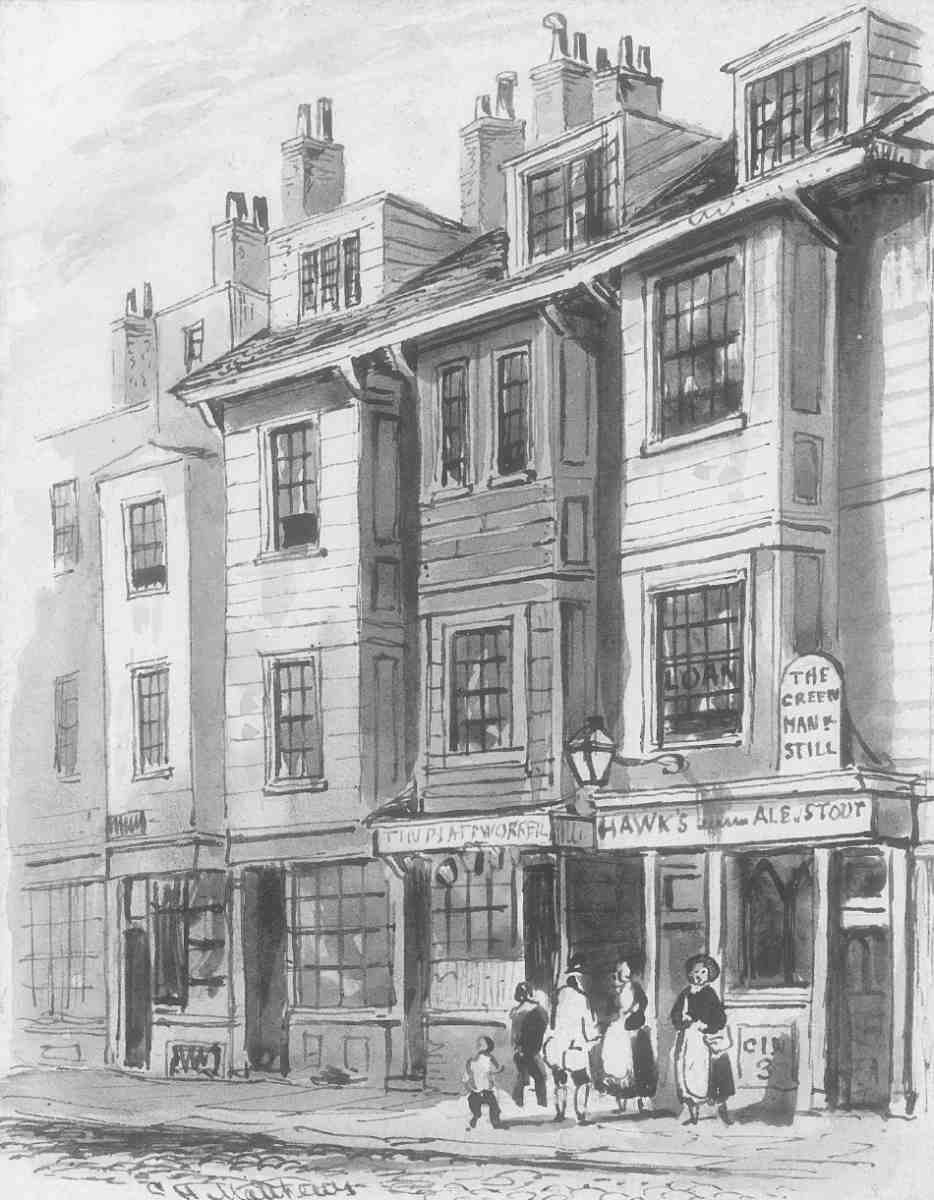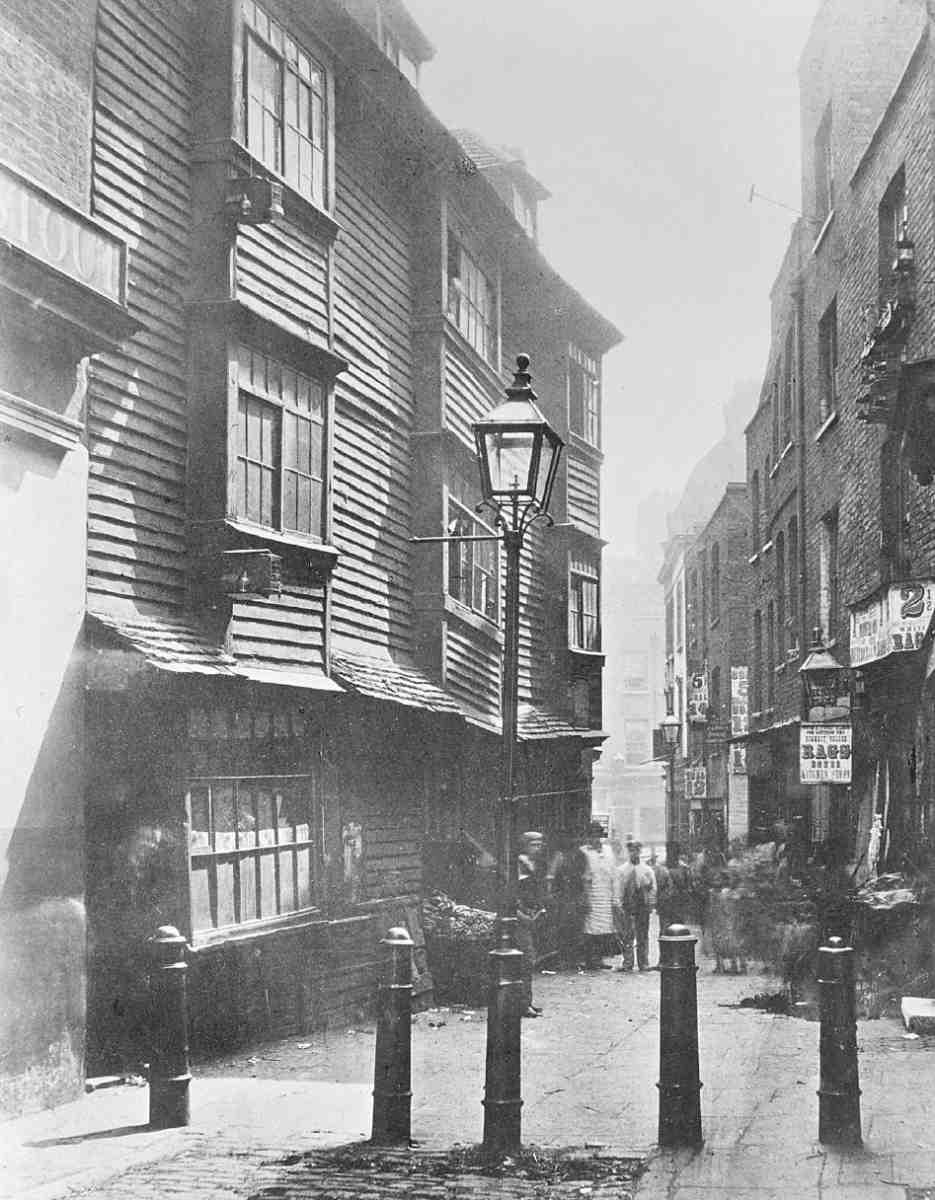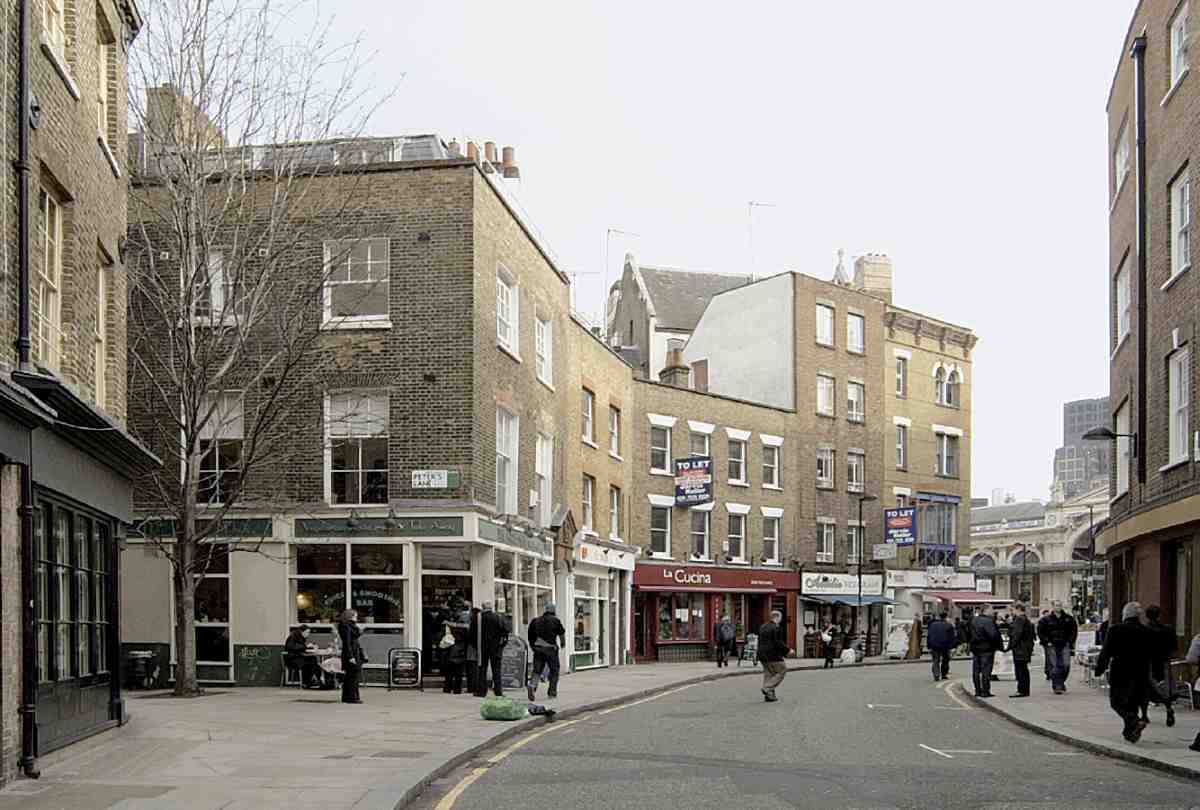In the Middle Ages, Cowcross Street and Turnmill Street were part of a main route out of the City of London to the North, eventually joining up with King’s Cross Road.
Cowcross Street was known as ‘Cow Cross’ until the end of the 18th century. You would think that Cow Cross got its name from cows crossing the street on their way to Smithfield market. But that wasn’t it at all. There used to be a large cross, like a big sign, set up where St John Street and Cowcross Street meet. This was the sign for the Smithfield Cow Market, which was a separate market from the main Smithfield Market which also traded in other livestock and horses. The cow market cross gave Cow Cross, and eventually Cowcross Street, their names.

The whole area around Cowcross Street was always heavily involved with the meat trade because of its proximity to Smithfield. There were livestock markets at Smithfield from Norman times.
As a main route in and out of London, the Cowcross Street area attracted several inns which aimed to profit from serving the travellers. The large number of taverns became magnets for crime and vice. For example, William Lancaster, the landlord of the Compass Tavern in the 1790s had a second occupation as a highwayman raiding coaches on Hounslow Heath.
Some industries set up in Cowcross Street. John Chubb, who started the lock and safe business, first operated from No. 27 Cowcross Street.
In 1790, James Schofield, whose factory was at No. 76 Cowcross Street, invented a ‘patent coach trumpet’ which could be installed inside coaches to allow the passengers to communicate with the coachmen sitting outside guiding the horses. And the coachmen could easily pass back ‘stand and deliver’ demands received from the local highwayman.
There were three big developments in the area in the 1860s which had considerable effects on Cowcross Street: the rebuilding of Smithfield market as a covered market for the sale of pigs and chickens; the construction of Farringdon Road; and the construction of the Metropolitan Railway which brought passengers and freight into and out of a new Farringdon station.
Smithfield cattle market was relocated north of King’s Cross., and many of the local meat rendering businesses which depended on it left with it. But some clung on. The catgut business remained strong – making violin strings. But guts were not just used for musical instruments. Gut bands were needed for machinery – this was after all the era before rubber – and even for clocks. Without gut manufacturers there would be no tennis rackets. Ticket holders at the Centre Court at Wimbledon should lift a glass of champagne in memory of the gut makers of Smithfield.

But the big thing in the late 19th century was bacon. The English had suddenly discovered a taste for bacon, and much of it came to be produced in smokeries set up around Cowcross Street, particularly near Peter’s Lane and Greenhill’s Rents. The bacon was cured in huge bacon stoves, some as much as sixty feet in height. The largest business in the 1880s was owned by Thomas Boyd – who the Press called the ‘bacon and ham millionaire’ – and his brother John.
They were eventually overtaken by the Danish Bacon Company whose headquarters from 1909 was at Nos. 9 – 13 Cowcross Street. They became the biggest bacon curers of all, with 19 huge brick stoves, which produced 30,000 sides of bacon each week. Danish Bacon’s business continued to operate from Cowcross Street until the 1980s. Another major bacon smoking business was run by J D Link & Son. Links’s factory was at Nos. 78 – 85 Cowcross Street and part of Greenhill’s Rents. Most of the smokeries were pulled down by the 1980s – the last one stopped operating in 1984 – but several smokery stoves were cleverly incorporated into the fabric of St John Restaurant and Bar – you can recognise them from their sets of doors high up in the walls.
Since the 1980s, Cowcross Street has been transformed by new office businesses taking over the area and displacing all the former industrial activities.
Cowcross Street – north side.
Cowcross Street starts with a little cluster of buildings ending at Peter’s Lane. Nos. 2 and 3 Cowcross Street are Victorian, but No. 1 Cowcross Street was rebuilt in 1952 after the original building had burnt down. On the other side of Peter’s Lane, the Rookery hotel is a 1998 conversion of a cluster of Georgian and Victorian houses.

Nos. 9 – 13 Cowcross Street is an interesting building. It was built in 1879 by James Warner, a metal grinder. It’s called Denmark House – you’ll see the name over the metal gate – and this memorialises its history as the headquarters of the Danish Bacon Co. It was lucky. Many historic buildings in Cowcross Street were knocked down to make way for recent new developments like Zinc House. But this one was saved by the council who made it a listed building in 1994. It was then converted by Ransome’s Dock Ltd into shop premises on the ground floor and very high ceilinged apartments in the three storeys above. Attractive features of the exterior include piers of red brick with large ornamental metal tie plates all the way up the building.

Nos. 14 – 16 Cowcross Street next door is another handsome building, built as a warehouse in 1867 in yellow brick with iron columns between the windows.

Nos. 17 and 18 Cowcross Street are possibly the oldest surviving buildings in the street – two small 18th-century shop-houses.
Zinc House is one of the new developments of the late 1990s. It’s part of the larger ‘Cowcross Estate’, as it is was called, which includes the City Pavilion and Eagle Court in a new courtyard.
With Sabian House at Nos. 26 – 27 Cowcross Street, we are back to the Victorian age. This building, which was constructed in 1880, has one of the most attractive façades in the street (at least above ground floor level, which is boring). It features what look like enormous colourful mushrooms above the windows.

No. 30-31 Cowcross St, which was originally called Ikon House and has a gated courtyard through to Faulkner’s Alley, looks for all the world as if it is a refurbished Victorian warehouse with a narrow modern building with huge church-style lancet windows beside it. In fact it was all built in the 1980s and just made to look like a Victorian warehouse. They even borrowed the mushroom style of decoration over the first floor windows from Sabian House next door.

Nos. 32-35 Cowcross St and Nos. 101-102 Turnmill St are a curved building consisting of a pub – The Castle, which is in Turnmill Street – flanked by warehouses on either side. Nos. 32-33 – the flank which is in Cowcross Street – has been given a cream-coloured stucco finish, while the pub and the building on the other side keep their Victorian look.

Cowcross Street then carries over to the area in front of Farringdon station. When the ‘Farringdon and High Holborn Station’ was built, the road in front was included in Cowcross Street. It is a strange section of street. From the station to the corner with Farringdon Road is a huge black box of a building. Opposite is a huge red box. Both have shops in the ground floor and offices above.

The south side of Cowcross Street
Nos. 61 and 63 Cowcross Street, opposite the Turnmill Street junction, are former Victorian warehouses built in the 1870s.
Warwick House at Nos. 64–65 Cowcross Street was built in 1962 in the latest (1960s) style with an all-metal exterior.
The Three Compasses pub at No. 66 Cowcross Street was bombed in the war and rebuilt for Truman Brewery in the late 1950s. Originally, it was all set back several feet from the line of the buildings on either side, but in 1982 the ground floor was rebuilt to extend it to the street boundary – giving the building its rather unique appearance.

Nos. 67 – 69 Cowcross Street was a cold storage building built for butchers. Later, in the 1960s, it was converted to office and bar use.
Nos. 70 – 77 Cowcross Street was built in 1921 as the shipping department for Thomas Cook, the travel company. In 1935 the Danish Bacon Co, whose headquarters were at Nos. 9 – 13 Cowcross Street opposite took the building over and added the most splendid Crittal windows you will ever see.

Nos. 78 – 85 Cowcross Street was originally the site of the bacon manufacturer, JD Link & Son. It wasn’t quite knocked down, but certainly substantially reworked in the late 1980s. It now has two distinctly different parts. No. 78 Cowcross Street is a concrete-framed building, but with a facing of dark grey bricks. There’s a courtyard behind. No. 85 Cowcross Street, which is called Market House, has a rendered exterior.

Nos. 86 – 89 Cowcross Street was once the Blue Post public house, built for the Wenlock Brewery just before the War. There must have been a tradition of building pubs in curved buildings with other buildings on either side – another example is the Castle on the corner with Turnmill Street.
On the other side of Greenhill Rents, Nos. 90 – 93 Cowcross Street, Greenhill House, is a big commercial Victorian building of the 1870s, with windows of the upper floors divided by iron columns.
The building on the corner with Charterhouse Street was originally constructed in 1877as a pub and a post office. The post office is now a sandwich shop. But the pub, the Hope, is still going strong. There has been a pub called the Hope on this site since the 18th-century. that Hope really does spring eternal.

